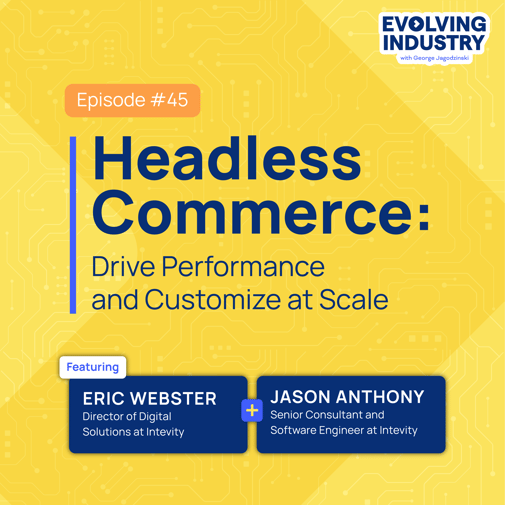Evolving Industry
Headless commerce platforms have become all the rage in large corporations like Google and Amazon.
But are these customizable solutions the right fit for your organization’s roadmap for growth? When is the right time to make the switch, or should you?
These are the types of internal conversations we love at Intevity. In the first part of our internal series, Jason Anthony, Senior Consultant and Software Engineer, and Eric Webster, Director of Digital Solutions, join the studio to share their thoughts.
Jason and Eric talked about:
- The benefits of a headless commerce framework
- How to determine the right platform for your business needs
- When small and simple solutions outperform one platform to rule them all
What Headless Commerce Can Do For Your Business
As e-commerce businesses scale, it’s not uncommon for front-end customer experiences to become stifled by rigid back-end development that leaves little room for custom integrations.
Consumers have exercised their wallets to let the digital marketplace know they’re eager to pay for a streamlined shopping experience.
It’s why many Fortune 100 companies, including Microsoft, Walmart, and Sony, have made the switch to headless commerce.
“Even the smallest delay can equate to real dollars and cents,” Jason argued. “The larger your organization is, the more that money actually impacts your business.”
So what are some early warning signs that your digital platform might be a dead program walking?
“It’s usually when your product team is asking you to do things, and you’re just like, ‘Ah, the platform doesn’t do that,’ or, ‘We can’t customize a platform to do that,’” Eric said.
Most companies will notice these hiccups in their digital platforms as they try to expand personalized offerings for their customer base.
“One of the biggest ones is loyalty [programs],” Jason mentioned. “Full commerce solutions may have something, but it’s probably not going to be as customizable as your product team [could] come up with.”
Of course, diagnosing your organization’s e-commerce needs is one thing. Finding the right solution is a different beast entirely.
The Special Sauce for Platform Integrations
Determining the best platform for your business typically involves a deep dive into essential features your customers crave.
“You really need to make a checklist of absolute must-haves,” Jason said. “This product has to be able to do these things.”
Once your priorities are in order, it’s a matter of putting the right pegs in the right holes. But with dozens of SaaS platforms promising the world to unwitting clients, how can you know which is right for your business?
As Eric suggested, this is when other trusted industry leaders can be your greatest resource because there’s a good chance one of them’s been in your shoes.
“[Ask] who does this the best. Talk to them and truly try to figure out [their] process. What parts of that did they struggle with? Would they do it the same way they did it before?”
However, even if you obtain a winning recommendation, a successful headless commerce integration ultimately comes down to your digital gold — data.
“Where do you have parity? Where are you using the same terminology?” Eric said. “That’s one of the biggest things that I think a lot of people struggle with when doing really complex integrations.”
Everyone loses if your data gets lost in the shuffle between legacy systems and a new complex platform. So how do scaling companies avoid this technological nightmare?
Headless Commerce Doesn’t Have to Be Complicated
Most business leaders would pay a small fortune for a one-size-fits-all game plan for their headless commerce playbook.
Unfortunately, neither of our guests has yet to see a platform that can truly excel at being everything for everyone.
“The likelihood that there’s one platform that does everything the best is very low,” Eric said. “You end up doing it really [well] when you focus on one service [or] one product.”
Eric also implied that adopting a single service promising a glut of features isn’t necessarily a good thing.
“Consolidation for consolidation’s sake is not always the right way,” he said. “One really big, complex thing doesn’t always mean it’s better than the four really small, simple things.”
And as Jason pointed out, these larger programs often aren’t even a true single entity.
“A lot of the time, that one program that you go into [is] comprised of smaller programs that all just use a solidary UI,” he said. “You may think that you’re solving the issue of the ‘one platform to rule them all.’ But really, all you’re doing is just consolidating the presentation player.”
Like with many other challenges leaders face with digital transformation, Jason and Eric lamented that there is no silver bullet for a seamless transition to a headless commerce platform.
Yet, with proper due diligence, headless commerce could be the key to unlocking your organization’s exponential growth — as long as you’re prepared to make the leap.
As Jason reminded us in closing, no one should take the investment lightly.
“Be cognizant of these things [and look] at every piece of connectivity,” he said. “Make sure, as an organization, that you’re mature enough to be able to make that step.”
Craving more? You can find this interview and many more by subscribing to Evolving Industry on Apple Podcasts, on Spotify, or here.
